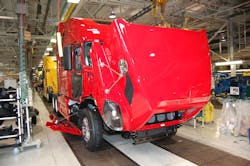Six consecutive months of strong Class 8 order volume ended abruptly in May, according to data tracked by research firm Stifel Capital Markets.
Class 8 orders in May topped 16,800 units and while that’s up 18% compared to the same month in 2016, it’s down 30% sequentially from April and below expectations, noted Michael Baudendistel, vice president of Stifel’s transportation and logistics research group, in a statement.
“We are not shocked, however, to see a mid-year lull in order activity materialize, as recent order trends have belied persistent weakness in core trucking markets,” he explained.
“While we still believe there is more potential upside than downside to our 215,000 unit 2017 forecast, given a steeper-than-expected decline in May, we are leaving [that] outlook unchanged for now,” Baudendistel added.Yet Don Ake, vice president of commercial vehicles for research firm FTR Transportation Intelligence, stressed that May’s order numbers “are not that worrisome” considering the steady volume of orders over the past seven months.
“It appears the typical summer order slump just showed up one month early,” he added. “It does indicate the market is functioning normally and there is a steady, not robust, upward trend. The slowdown in order activity will give the OEMs a chance to get production lined up with demand.”
Total Class 8 orders for the past twelve months are running at about 211,000 units right now, Ake pointed out, and FTR still expects the Class 8 build and sales to continue to increase as the year progresses.
“May orders were actually very close to our January forecast, so the market continues to move ahead as expected,” he noted. “Orders should continue at about this pace through the summer, which will be good enough to support stronger demand in third and fourth quarters.”
Steve Tam, vice president at ACT Research, added that May is usually the month when the “seasonal adjustment” in Class 8 orders for the summer begins.
“While the magnitude of the decline is greater than expected, the timing is spot on,” he emphasized. “May is typically the time of the year when order intake drops below average.”
Volvo Trucks North American (VTNA) is one OEM that still thinks the North American Class 8 market will top 215,000 units for the year –a level of production volume being driven in part by strong construction spending, which the OEM said is at its highest level since 2007.
Magnus Koeck, VTNA’s vice president of marketing and brand management, explained to journalists gathered in Winston-Salem, NC, last week to test drive the OEM’s new VNR regional haul truck that a strong labor market and consumer spending will drive U.S. gross domestic product (GDP) growth this year, with moderate manufacturing growth adding to that growth and, in turn, helping bolster Class 8 sales.
“Diesel prices are also low and the Department of Energy now expects just a 2.2% annual increase in diesel prices until 2040,” he added.
That doesn’t mean VTNA is looking at the commercial vehicle market through rose-colored glasses, however.
Koeck noted that the long haul segment is declining largely due to weak freight demand and rates, along with excess used truck inventories.
He added that looking at Class 8 registrations year to date though March of 2016 and 2017 side by side, “we see a drop in long haul from 46.8% to 41.2%.” Altogether, total Class 8 registrations dropped from 59,481 units year-to-date through March of 2016 to 45,856 units year-to-date through March of 2017.
Meanwhile, the regional haul market is expected to remain flat in the U.S., maintaining a consistent 28% of Class 8 market share, though there will be a continued trend towards freight regionalization spurred on in part by the growing driver shortage.
“For 2017 what we expect is that regional [demand] will stay balanced but flat,” he pointed out. “Yet there’s a change in transportation patterns towards less driving distances and less sleeper use. But we do expect long haul to pick up slightly at the end of the year.”
That coincides with the view Stifel’s Baudendistel is taking of the Class 8 market.
“We believe the Class 8 order weakness in May should be viewed as a step back from unsustainable levels,” he explained. “Overall, we continue to view North American [commercial] truck order trends over the past several months favorably, and believe conditions are setting up well for a strong 2019-2020, which should be years with significant replacement demand.”
About the Author
Sean Kilcarr
Editor in Chief
Sean Kilcarr is a former longtime FleetOwner senior editor who wrote for the publication from 2000 to 2018. He served as editor-in-chief from 2017 to 2018.


